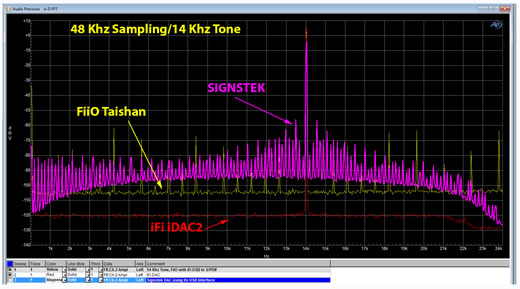- AccurateRip
- Acoustid
- AES/EBU
- AirPlay
- Amplifier
- aptX
- Audio file formats
- ASRC
- AVB
- Bit perfect jitter
- Bits: 16 or 24
- Bit perfect playback
- Bitrate
- Bluetooth
- Burn-in
- BWF
- Cables
- CDtext
- Chromecast
- Clipping
- Clock
- Codec
- Compression
- CRC
- Crossover
- Cue sheet
- DAC
- Damping
- DASH
- Digital
- Digital Room Correction
- Dither
- DLNA
- Drivers
- DoP
- DSP
- EBU R128 (loudness)
- FFT
- FireWire
- Freedb
- Gapless playback
- Generation loss
- HDMI
- Headphone listening
- Hearing
- Hires recording
- Homeplug
- I2S
- ID3
- Inter sample peak
- LDAC
- Linearity (DAC)
- Memory playback
- Music Server
- OCF
- OFC
- PCM
- Perception
- RAID
- ReplayGain
- Ripping
- RFI
- RIAA
- Router
- Sampling, up and over
- Sample Rate Conversion
- Speakers
- S/PDIF
- Storage
- Sync
- Tagging
- Toslink
- Transcoding
- UAA
- Units
- UPnP
- USB
- VST
- WiFi
- WiSA
DAC
Digital audio is PCM (Pulse Code Modulation) audio most of the time.
It consist of two components, the value of the signal (represented by 16 or 24 bits words) and the time step (sample rate).
We have two components, the signal and the time.
Sounds logical but pretty often you hear the 'bits are bits' theory, implying that if the bits are right, everything is right. This theory leaves the other half, the time step, out of the equation.
To play PCM audio, the bits has to be translate to a equivalent voltage and this must be done with a time step matching the sample rate.
This is done by a Digital to Analogue Converter, a DAC for short.
The sample rate is generated by a clock.
As absolute perfection does not exist, there is always some fluctuation in clock speed.
This is called clock jitter.
Interface jitter is jitter introduced in the transmission of digital signals.
Noisy power supplies, improper grounding and electromagnetic interference could also induce jitter.
Crucial is the sampling jitter, deviations in the sampling interval in the DA conversion stage
According to the Redbook audio standard the clocks frequency should be within +/-100ppm (parts per million).
A deviation of 100 ppm means that a 440Hz tone deviates +/- 0.044Hz.
NOS
The first generation was Non Over-Sampling.
The DAC simply runs at the speed of the incoming stream.
Inherent to the conversion is that higher-frequency multiples of the audible range are created, the so-called aliases. In case of CD audio, the sampling rate is 44.1 kHz; the audible range is the half, so the first alias will start at 22.050 kHz.
To avoid that these aliases burn you tweeters, a low pass filter is required.
This filter starts at 20.000 and has to remove everything before the first alias starts (22.050 assuming CD audio) so it has to be very steep (brick wall filter). Filters this steep are expensive, complex and introduce all kind of artifacts like phase distortion and pre-ringing.
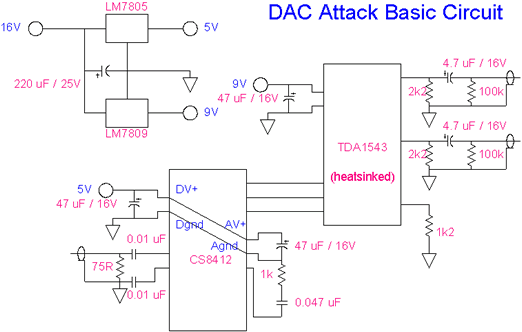
Schema of a NOS DAC
Most DAC’s today use oversampling to avoid the filter problem.
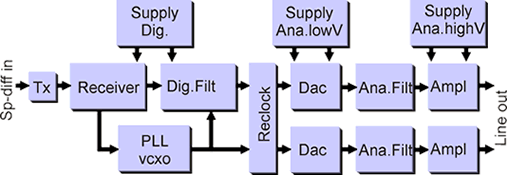
Schema of a modern DAC
- The receivers extract the data (the signal) and the clock from
incoming signal.
In general this is S/PDIF over coax or Toslink. Modern DACs offers USB input to.
- A digital filter might be used to do SRC (sample rate conversion)
- Some DACs do re-clocking; it makes them less sensitive to input jitter.
- The DAC chip converts the digits to a current
- The current is converted into a voltage (IV converter)
- This signal is filtered to get rid of the switching noise.
- The amplifier is needed to bring the signal up to line level (just like a phono stage).
There are other designs possible, an overview can be found here: http://en.wikipedia.org/wiki/Digital-to-analog_converter
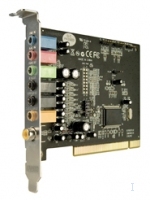 |
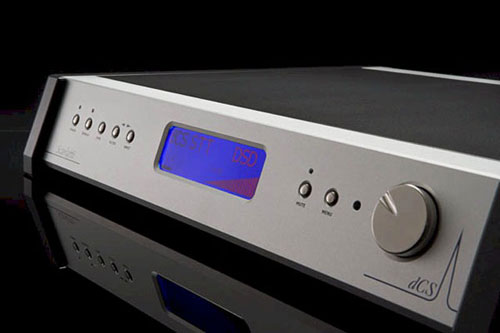 |
| € 19.500 |
A DAC might be a sound card or a separate box.
Building a DAC
Very few companies build their own DAC (the chip doing the DA conversion)
dCS and Chord are the ones I know using a FPGA to build their own converter.
Most companies use a chipset by Burr Brown (TI today), AKM, Wolfson, Analog Devices, ESS, etc.
Linearity
The number of bits a DAC supports is a nominal value.
It is not the performance metric.
All it says is that the DAC accepts samples with a 16 or a 24-bit word length.
Not to be mistaken for being able to resolve this sample to the last bit.
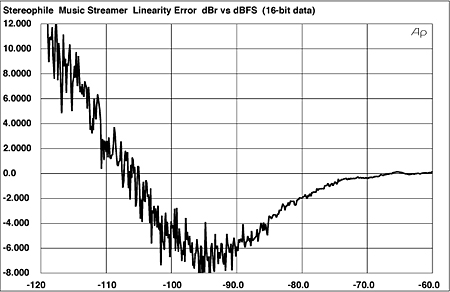
A perfect DAC would have no linearity error.
As you can see in the graph, this DAC starts to deviate at -70 dBFS.
As 70/6=11.6 this DAC is more or less able to reproduce 12 of the 16 bits perfect.
High quality DACs are able to reproduce up to 22 bits correctly.
This is discussed in more detail here.
Reconstruction filter
A DAC translate each sample into an analog signal.
It does so for each time step.
Hence the output is analog but stepped.
To smooth these steps, a reconstruction filter is needed.
Indeed it reconstructs the original continuous signal.
Filters are a beast. They always create anomalies in the frequency domain or in the time domain or both.
Today a DAC often has an interface allowing you to choose different reconstruction filters.
Archimago tested the impulse response and the resonse in the frequency domain of various filters.
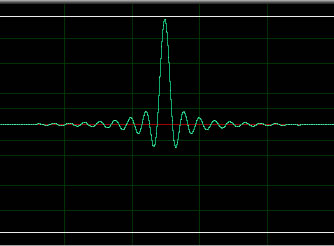
Lineair phase filter
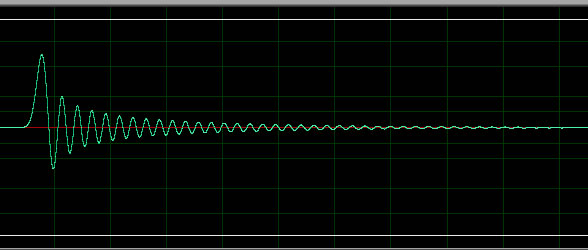
Minimal Phase filter
Digital Filters and Impulse Response... (TEAC UD-501) - Archimago's Musings
Selectable filters
Today DAC’s often allow you to choose between various filters.
Thorsten Loesch offers a nice explanation why we would need them.
The main reason would be that some Digital Filters measure very well when using something like an AP2, but the sound quality is not great.
On the other hand some of the Filters that many find good sounding (including no filter at all) measure, shall we say interesting, on an AP2 (here is one for the AP2 and 'scope jockeyes - how come often what measures quite poor sounds great?).
One way around this is to make the filter switchable, Ayre did this quite tongue firmly in cheek by labelling one position for the filter "Listen" and the other "measure". So AP2 and 'scope jockys can marvel about the great measured results while people who prefer to listen to music may choose what sounds better and not worry about what it measures like.
Price and performance
Today DACs come very cheap. $20 buys you one.
How do they perform?
Amirm compared
- FiiO D3 $19.99
- Signstek Mini USB DAC $21.99
Reference was a iFi iDAC2 which retails for $349.
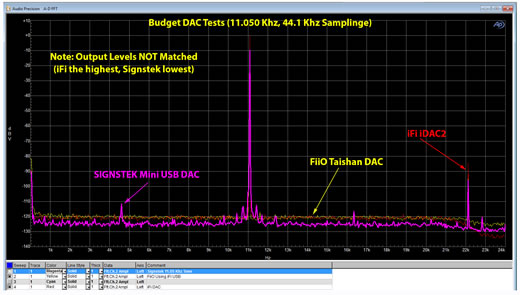
11 kHz at 44.1 kHz
14 kHz at 48 kHz
At 44.1 these cheap DACs perform fair, pretty close to the reference.
At 48 they fail.
Review and Measurements of Budget ($20) DACs - Audio Science Review
Feeding the DAC
Ask in an audio forum “what is the best way to connect the PC to the audio” and the replies will probably be
- Take a USB DAC; there are some pretty good ones out there
- No, go FireWire, much better, USB sucks
- No, a good internal sound card equals all these expensive external boxes at a fraction of the cost.
- Get a media center with SPDIF out.
- Get a Mac mini
- Use a Squeezebox
- Etc.
Onboard sound card uses the PCI-bus. The analogue out in general is RCA; the pro-models have balanced out (XLR).
An outboard DAC can be connected using Toslink, SPDIF, AES/EBU, USB, FireWire, Ethernet, Wi-Fi and then I don’t mention protocols like MADI, ADAT, CobraNet and other pro-stuff.
Toslink, SPDIF, AES/EBU are popular in the audio world.
It are uni-directional protocols, there is no 2-way communication.
The sender starts to stream in real time and the receiver has to lock on the incoming stream.
In principle, any variation in clock speed by the sender will result in input jitter at the receiver (the DAC). There are tricks to improve on this like ASRC.
USB and FireWire are typically computer protocols.
Both can be used in different modes.
In asynchronous mode the DAC times the bus.
In this scenario the clock of the DAC can run at a fixed speed as there is no need to sync on an incoming stream. This mode is the solution to eliminate input jitter.
Networking over Ethernet (wire) or Wi-Fi (wireless) is asynchronous by design.
Packages of data are send using a protocol like TCP/IP.
This protocol is very strict; it is built with bit perfect transmission in mind.
It is a bi-directional protocol, if a package fails the checksum test, the receiver simply tells the sender so and it will get a new one.
Measurements
A lot of audio companies don’t publish measurements.
They rather speak marketing.
Maybe they are right. You probably make a higher profit by hiring an excellent marketer than by hiring an excellent engineer.
A common measurement is the J-test.
A single signal at a ¼ Fs is played.
You won’t see it skirting and you won’t see sidebands.
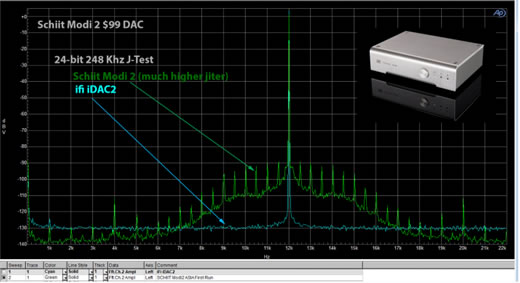
One can also test for linearity, harmonic distortion, tntermodulation distortion, etc.
A good description can be found Understanding Audio Measurements
- An Introduction to Delta Sigma Converters - Uwe Beis
- ADC and DAC Glossary - Maxim
- List of NOS DACs - AudioStream
- The Data Conversion Handbook - Walt Kester
- Digital Filters and Impulse Response... (TEAC UD-501) - Archimago's Musings
- What are Digital Filters and why are they used in the INVICTA? - Resonessence Labs
- The Bits In-Between - An EE's Guide to Survival Between Microphone and Voice Coil - Bruno Putzeys
- Review and Measurements of Budget ($20) DACs - Audio Science Review
- Understanding Audio Measurements - Amir Majidimehr


